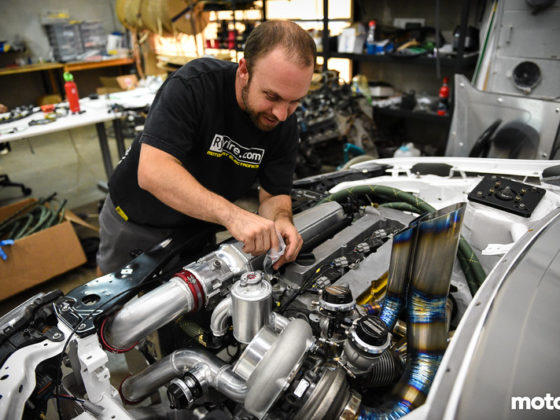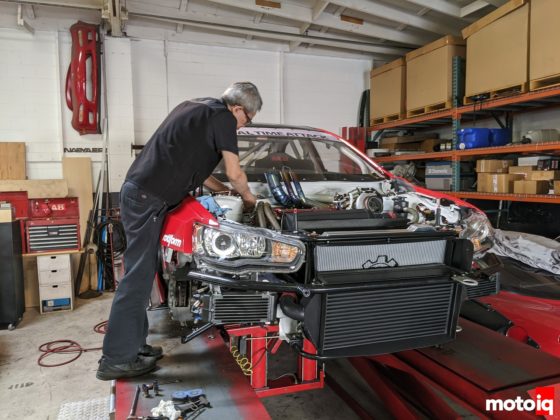
The instructions say that you should bolt the shifter up, and then run everything through the gears. They say it’s possible you might need to jiggle the shifter adapter one way or another to get everything to happily line up and get everything to go through all the gears. Since my transmission has less than 100 miles on it, it was pretty tight, so everything went smoothly.
Then you’re supposed to drill holes through the block all the way down into the bottom plate to install roll pins. That seems like a gigantic pain in the ass with much room for error. So we got the shifter working well, tightened it down, and then removed the block to drill the holes using the Bridgeport.

The new holes allow roll pins to be driven down into the adapter plate. The old holes will enable the block to bolt to the shifter adapter. They cannot occupy the same space at the same time.

This was a million times easier than trying to drill the holes with the block in the car. It also helps to ensure that the roll pin holes are perfectly straight.
With the roll pin holes drilled, we checked the shifter one last time. To check it, I simply started the engine and tried to go through all of the gears with the car on jack stands at low speed. It went from neutral all the way up to 6th, and then back down. Then we stopped, engaged reverse, and that worked, too.
Confident that everything was working, we took it all apart again.

S1’s adapter plate mostly covers this middle bolt hole on the vehicle’s left side. But it doesn’t completely cover it. We took a stud and some liquid gasket and inserted it flush with the transmission surface to “fill” the hole. This would ensure nothing could splash up onto the area and then leak out of the trans. We also noticed the reverse lockout solenoid block-off plate wasn’t installed well, so that was removed and replaced to ensure a leak-free fit.




12 comments
When will this car see some hard use and put all these bits to the test?
If you subscribe to my personal YouTube channel I’ll have video from Carolina Motorsports Park where I was beating it up a good bit. Even ended up mowing the lawn at some point! I ran 1:48 which is almost 9sec off the TT2 pace, but this is the first real experiment on the car and my first time at CMP in over a decade. I’ve got a lot to learn about the corner speed limits of the car. Looking at my data it’s basically “yeah just go faster everywhere”. Ha!
@clay There are now some videos on my YouTube: https://www.youtube.com/user/erikmjacobs
Awesome! Those shifters look like so much fun. The date on the vid os wrong? It says 2010. I will check out your You tube.
@erik yes the date was wrong. I can’t change it and YouTube got rid of annotations, so I just blurred it out.
I’ve driven that shifter before and you really can’t rush a shift with it. My friend wallered one out after a couple of race seasons and it began to miss gears, I think there’s a lot of leverage working against it. That and once worn, I think the housing grows with heat and makes it worse. I had the B&M and it sucked when it heated up. I love my new MGW and don’t see myself running anything else now.
I noticed that the shifter assembly was pretty warm after a session, but I’m also not running a transmission fluid cooler.
The MGW looks nice, but it’s a standard H-pattern and not a sequential. I didn’t really have any issue with the factory Tremec shifter, other than I really wanted a teeny tiny short handle. That Hurst handle I had was pretty good, but I would’ve liked something even shorter. The THROW wasn’t the problem. It was more the shift handle length.
We’ll see how the S1 holds up after time. My only issue with it is more user error than a problem with the shifter. For whatever reason, I tend not to push it forward enough, so I end up not fully engaging the next gear down. It’s not really a big deal — just something I need to work on or perhaps adjust the shifter angle a bit more.
The shifter sort of has 2 clunks to grab a gear, don’t let the first one fool you. It can be pretty convincing. I’ve found with the MGW that reverse is an asspain to grab, so if this doesn’t do it for you long term consider the MGW as an alternative to not grabbing reverse when you want 5th. I did that years ago to another T56 with a worn out stock shifter and reverse was never the same after that.
Great article, this Soarer content is always so interesting to read. Great vocab too, automotive project car stories can often fall into “catalogue details” faster than the wonders of gearbox black magic. 10/10
Thanks, Brad! I’m grateful to know that the effort I put in is appreciated!
is there a difference between a sequential trans and a sequential shift trans? reason I ask is because I had a chance to get an “ikeya sequential shifter” for cheap but a friend poo-pooed it saying that is not a real sequential trans –can anyone shed some light on the subject
Yes, and no, and kind of. Context matters.
In the case of the S1, Ikeya, and other adapters, you are attaching a sequential shifter assembly to an otherwise normal tranmission. So, while the activation of gears becomes sequential (you can only select the next or previous gear, “sequentially”), the clutch is still required in order to keep the other parts of the transmission happy (namely the synchronizers on the transmission gears).
A true sequential transmission usually has an internal construction that allows for changing gears without needing to disengage the engine from the transmission via the clutch. A true sequential transmission may use either a physical shift lever (like V8 Supercar a few years back, late 90s BTCC, old DTM, etc) or shift paddles on the steering wheel.
Sequential transmissions may, but don’t have to be, integrated into the engine management system to handle things like rev matching. They often still have a clutch for starting from a dead stop, but the clutch is not required for switching gears once moving.
Where it gets funky is in modern dual-clutch transmissions and automated manual transmissions. I think the Volkswagen-Audi group DSG may have been one of the first “passenger” units on the dual-clutch side, and BMW with the SMG on the E46 M3… maybe.
In the case of the dual-clutch unit, it is much like a regular manual inside, but there are two clutches and two input shafts and a computer that controls how things work. While the experience is sequential (use a paddle or push/pull on the shifter to get the next gear), there are still clutches and synchros inside. The BMW SMG more or less used a computer to actuate the regular single clutch. These systems may or may not have a clutch pedal at all, as the computers do all of the work, including starting from a dead stop.
I hope this helps!